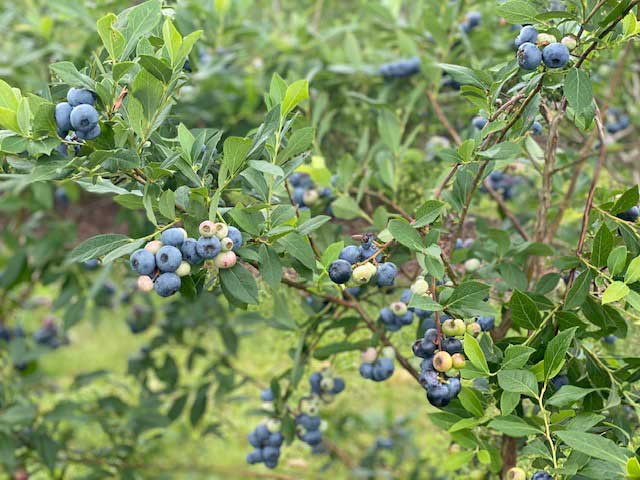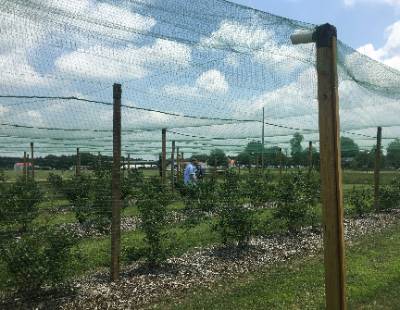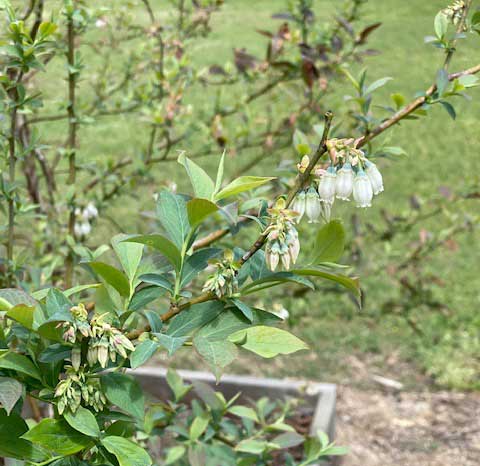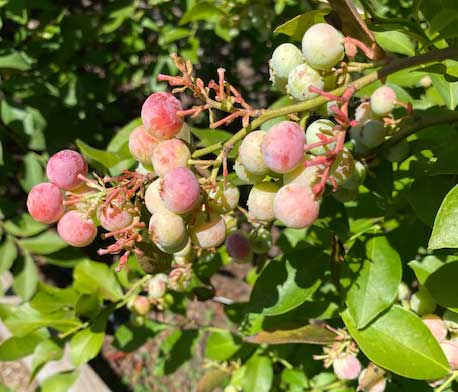Self Sufficient U Blog
Contact
Clark County Extension Service
Amy Simpson, Horticulture
Cindy Ham, 4-H and Ag
JoAnn Vann, Family & Consumer Sciences
Phone: 870-246-2281
Email: clark-arkadelphia@uada.edu
Follow us on
Facebook
Clark County
Cooperative Extension Service
640 S 6th Street Suite B
Arkadelphia, AR 71923

Red, White, and Blueberries!
Amy Simpson
It’s nearing Independence Day, the time we enjoy eating fresh berries, making homemade ice-cream, counting lightening bugs, and shooting fireworks. Unless you live in the Arkansas delta.
Growing up in southeast Arkansas I was bound and determined to have a great at-home fireworks show one year. My mama tried to warn me, but I knew better. Mosquitoes had nothing on me. A hot July night dressed in long pants, boots, a jacket with the hood pulled up and cinched tight around my face and then a nice shower in mosquito “dope” was all I needed to make it happen.
I didn’t last five minutes.
At least now in southwest Arkansas I can enjoy my fireworks without inhaling mosquitoes.
But let’s go back to fresh berries…
One thing you may want to try to become more self-sufficient around your home is to grow your own fruit. In south Arkansas, we can successfully grow apples, pears, peaches, plums, nectarines, blackberries, muscadines, and blueberries. There are even some improved varieties of the native pawpaw that some are trying.
If you are interested in growing fruit, but are intimidated about it, I highly recommend starting off slow and easy with one of the more low maintenance ones to grow: blueberries.
Blueberries don’t have any major insect or disease issues and don’t require any special trellising or support systems, so they are perfect for the beginner.
Three Ways to Successfully Grow Blueberries
-
Start with the soil.
Sometimes as a county agent, I feel like a broken record when it comes to the soil. We always start there. Making sure your soil is in the right condition to successfully grow your crop before you plant is so important.
Blueberries like an acidic soil, in the pH range of 4.8-5.4.

That’s great for most of Clark County because most of our soils are naturally acidic but be sure to bring in a soil sample for testing to make sure. Lighter, loamy soils are better for blueberries, and it is common to mix a gallon or so of peat moss into the planting hole. Blueberries have a shallow root system and do not do well in standing water. Be sure to choose your site carefully to avoid soils that don’t drain well. It is also customary to berm up the soil into a raised bed for blueberries for this purpose. If you are wanting to plant new blueberries next Spring, now is a great time to get started preparing your soil.
-
Choose varieties carefully
In south Arkansas, we can grow rabbiteye and southern highbush varieties successfully. Both have good heat and disease tolerance. North Arkansas folks can grow northern highbush varieties since they require cooler temperatures for flavorful fruit and aren’t tolerant of the higher temperatures we get in south Arkansas.
Rabbiteye types are generally not self-pollinating, so you will need to plant two or more rabbiteye cultivars for fruit-set. Also, although southern and northern highbush cultivars are considered self-fertile, it is still a good idea to plant two or more of whichever type you are using for better and bigger fruit-set.
So, within each type, what cultivars are recommended? Our Small Fruit Cultivar Recommendations for Arkansas publication is a great guide to help you decide which cultivars will do best for your situation.
-
Proper maintenance and care
As I mentioned, blueberries are the most low-maintenance fruit you can grow here in south Arkansas, but they do still require some basic care.
Mulching with sawdust, pine straw, or wood chips benefits blueberries by helping the soil retain moisture and keeping the weeds suppressed. Blueberries don’t compete well with aggressive grasses like Bermudagrass or Johnsongrass, so be sure to get those controlled before planting and then use a thick layer of mulch to help keep them suppressed. Just remember to keep the mulch pulled several inches away from the branches of the blueberry shrub to prevent rot.
Although you should pull a soil sample soon and amend as recommended to lower your pH if needed before planting next spring, do not fertilize at planting. Wait until new growth begins and then apply 10-10-10 at 2 tablespoons per plant in a 12 inch band around the base of the plant, unless your soil test results tell you differently. Follow up after six weeks with 1 tablespoons of ammonium sulfate in a 12-inch circle around the plant.
Because of their shallow root system, they don’t like “wet feet” or standing in water, but the highbush cultivars especially do not tolerate dry weather for the same reason. Rabbiteye cultivars are more tolerant of dry weather, but the overall health and yields will be improved by regular irrigation during dry spells. Have some way of irrigating during dry periods, making sure the root zone of young plants stays moist during droughts, and mature plants are receiving 1-2 inches or water every 10 days or so.

For the first two years after planting, remove the flower buds from the ends of the shoots.
This will allow your plant to develop into a stronger, heavier producing shrub because you are not allowing it to expend any energy on reproduction while the plant itself becomes established.
As far as pruning goes, start selectively removing older canes after the second growing season. This will help shape the shrub keep it productive, creating larger berries instead of overloading the plant with many, smaller berries.
The main pest problem you will probably face is birds.

This is a problem I’m experiencing now. I had great intentions of building a net frame with PVC pipe and zip-typing bird netting around it, but life got busy, and now I’m noticing a lot of empty blueberry stems where actual blueberries used to be. Using some type of frame with netting is the ideal way to prevent loss from birds. Simply laying a net over the shrubs still allows birds to reach the berries on the outside. Sound deterrents making loud, erratic noises can sometimes work, but are not as reliable as a netting frame. Plus, if you live in a neighborhood, noisemakers will not make your neighbors think kindly towards you.
For more details on the planting, fertilizing, and pruning of blueberries, be sure to read our Blueberry Production in the Home Garden publication.
As we enter our most patriotic month of the year and fresh berries are in season, start making plans to grow your own next year! Blueberries are considered a “super-food” and are easy to grow, so why not start there?
If you have any questions regarding growing your own blueberries, please reach out to your local county Extension agent.